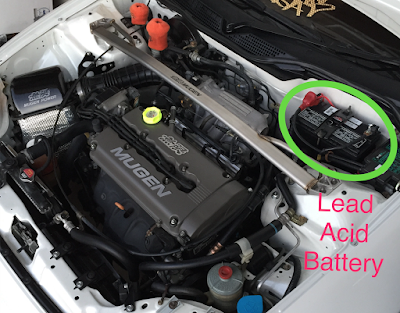In order to understand what causes batteries to fail you must understand how they work and what goes on inside them.
Most of us have a car or project vehicle that sits in the garage for prolonged periods of time without being driven. And I'd go out on a limb and say most of us have also inadvertently allowed the car to sit so long without starting it that the battery turned up flat, or dead from this down time. The purpose of this blog is to explore what causes corrosion, shedding, electrical short, sulfation, dry-out, acid stratification and surface charge. Understanding these items below will allow you to keep your battery in top running order!
A lead-acid battery goes through three life phases: formatting, peak and decline (Figure 1). In the formatting phase, the plates are in a sponge-like condition surrounded by liquid electrolyte. Exercising the plates allows the absorption of electrolyte, much like squeezing and releasing a hardened sponge. As the electrodes activate, the capacity gradually increases.
Formatting is most important for deep-cycle batteries. They require 20–50 full cycles to reach peak capacity and field usage does this. During break-in, manufacturers recommend going easy on the battery. The full cranking power is available from the beginning, although CCA will go up slightly with formatting in early use.
A deep-cycle battery delivers 100–200 cycles before a gradual decline begins. Replacement should occur when the capacity drops to 70 or 80 percent. Some applications allow lower capacity thresholds but the time for retirement should never fall below 50 percent as aging may hasten once past the prime.
To keep lead acid in good condition, apply a fully saturated charge lasting 14 to 16 hours. If the charge cycle does not allow this, give the battery a fully saturated charge once every few weeks. If at all possible, operate at moderate temperature and avoid deep discharges; charge as often as you can. We recommend some great charges at the bottom of this blog.
The primary reason for the relatively short cycle life of a lead acid battery is depletion of the active material. According to studies, plate/grid-related breakdown has increased from 30 percent 5 years ago to 39 percent today. The report does not provide reasons for the larger wear and tear other than to assume that higher demands on the starter battery in modern cars induce added stress.
While the depletion of the active material is well understood and can be calculated, a lead acid battery suffers from other infirmities long before plate- and grid-deterioration sound the death bell. Most of these can be reduced by proper maintenance.
Furthermore, we at throtl.com recommend a good battery tending device to aid in keeping your lead-acid battery in top shape. Keeping the battery in it's prime operating range instead of repeated cycling will ensure you get the most out of your lead-acid battery. We've listed a few great chargers below that are cost effective and will keep your project on the road for a long time!
Figure 1: Cycle life of a battery.
The three phases of a battery are formatting, peak and decline.
Courtesy of Cadex
Formatting is most important for deep-cycle batteries. They require 20–50 full cycles to reach peak capacity and field usage does this. During break-in, manufacturers recommend going easy on the battery. The full cranking power is available from the beginning, although CCA will go up slightly with formatting in early use.
A deep-cycle battery delivers 100–200 cycles before a gradual decline begins. Replacement should occur when the capacity drops to 70 or 80 percent. Some applications allow lower capacity thresholds but the time for retirement should never fall below 50 percent as aging may hasten once past the prime.
To keep lead acid in good condition, apply a fully saturated charge lasting 14 to 16 hours. If the charge cycle does not allow this, give the battery a fully saturated charge once every few weeks. If at all possible, operate at moderate temperature and avoid deep discharges; charge as often as you can. We recommend some great charges at the bottom of this blog.
The primary reason for the relatively short cycle life of a lead acid battery is depletion of the active material. According to studies, plate/grid-related breakdown has increased from 30 percent 5 years ago to 39 percent today. The report does not provide reasons for the larger wear and tear other than to assume that higher demands on the starter battery in modern cars induce added stress.
While the depletion of the active material is well understood and can be calculated, a lead acid battery suffers from other infirmities long before plate- and grid-deterioration sound the death bell. Most of these can be reduced by proper maintenance.
Furthermore, we at throtl.com recommend a good battery tending device to aid in keeping your lead-acid battery in top shape. Keeping the battery in it's prime operating range instead of repeated cycling will ensure you get the most out of your lead-acid battery. We've listed a few great chargers below that are cost effective and will keep your project on the road for a long time!
HAPPY MOTORING!
Some excerpts and illustrations borrowed from:
Buchmann, Isidor. "How to Restore Lead-acid Batteries." How to Prolong and Restore Lead-acid Batteries - Battery University. Cadex, 3 July 2016. Web. 19 Jan. 2017.
HAPPY MOTORING!
Buchmann, Isidor. "How to Restore Lead-acid Batteries." How to Prolong and Restore Lead-acid Batteries - Battery University. Cadex, 3 July 2016. Web. 19 Jan. 2017.

